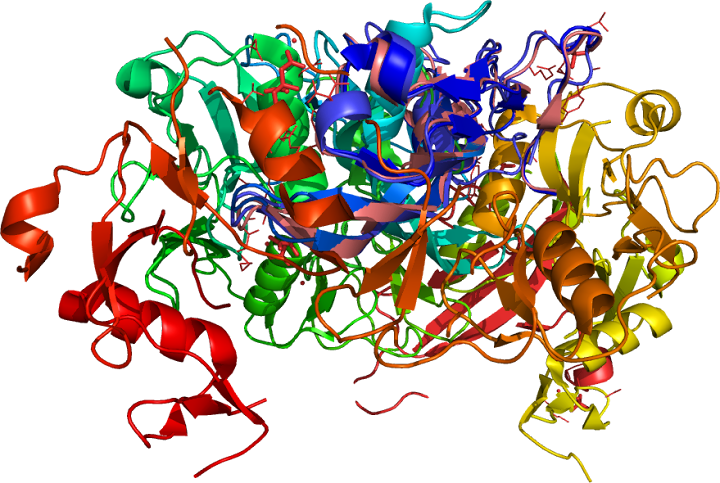 Myostatin , also known as growth and differentiation factor 8 (GDF8)
a TGF-beta
family member is (an inhibitor of myogenesis) secreted into the plasma expressed in human
skeletal muscle
(expressed in many different muscles
throughout the body) as a 12.5-kD propeptide
and a 26-kD glycoprotein (myostatin-immunoreactive protein) a dimer
(three exons and two
introns) locus: 2q32.2 [§§; ^] and WFIKKN2 protein (WAP, follistatin/kazal, kunitz, immunoglobulin, and netrin domain (WFIKKN2) containing 2) binds
mature GDF8/myostatin and myostatin propeptide WFIKKN1 the paralogue
(functional overlap) of these proteins. Myostatin
» decreases muscle mass*, Myostatin-binding
protein FLRG Protein,
Myostatin , also known as growth and differentiation factor 8 (GDF8)
a TGF-beta
family member is (an inhibitor of myogenesis) secreted into the plasma expressed in human
skeletal muscle
(expressed in many different muscles
throughout the body) as a 12.5-kD propeptide
and a 26-kD glycoprotein (myostatin-immunoreactive protein) a dimer
(three exons and two
introns) locus: 2q32.2 [§§; ^] and WFIKKN2 protein (WAP, follistatin/kazal, kunitz, immunoglobulin, and netrin domain (WFIKKN2) containing 2) binds
mature GDF8/myostatin and myostatin propeptide WFIKKN1 the paralogue
(functional overlap) of these proteins. Myostatin
» decreases muscle mass*, Myostatin-binding
protein FLRG Protein,  follistatin-related
gene « (15 g whey) via signals originating from the gut (e.g., GIP),
increased mRNA
muscle
cell (anabolic-stimulus*) proliferation and differentiation, adipogenesis
is blocked by RNAi silencing of signal to Wnt/beta-catenin/TCF4 pathway muscle and adipose tissue develop from the same mesenchymal stem cells.
Synthesized
(removed by subtilisin-like
proprotein convertases (SPCs))
is the biologically active portion of the protein that hSGT
(human small glutamine-rich tetratricopeptide repeat-containing
protein) may play a role in regulation, and complexes with
amyloid-beta like signal sequence. Myostatin circulates as part of a
latent complex containing follistatin-related gene FLRG. Activin type II receptors (ActRIIs) transmit the activin-binding protein (FLRG)
a protein that binds and inhibits activin*, the polymorphisms, showed
their relation to - left » ventricular mass (LVM)
- of endurance, acitvin receptor type « ACVR-
IIB and the myostatin propeptide is known to bind and inhibit
myostatin in vitro.
follistatin-related
gene « (15 g whey) via signals originating from the gut (e.g., GIP),
increased mRNA
muscle
cell (anabolic-stimulus*) proliferation and differentiation, adipogenesis
is blocked by RNAi silencing of signal to Wnt/beta-catenin/TCF4 pathway muscle and adipose tissue develop from the same mesenchymal stem cells.
Synthesized
(removed by subtilisin-like
proprotein convertases (SPCs))
is the biologically active portion of the protein that hSGT
(human small glutamine-rich tetratricopeptide repeat-containing
protein) may play a role in regulation, and complexes with
amyloid-beta like signal sequence. Myostatin circulates as part of a
latent complex containing follistatin-related gene FLRG. Activin type II receptors (ActRIIs) transmit the activin-binding protein (FLRG)
a protein that binds and inhibits activin*, the polymorphisms, showed
their relation to - left » ventricular mass (LVM)
- of endurance, acitvin receptor type « ACVR-
IIB and the myostatin propeptide is known to bind and inhibit
myostatin in vitro.